Related Research Articles

Murad IV was the sultan of the Ottoman Empire from 1623 to 1640, known both for restoring the authority of the state and for the brutality of his methods. Murad IV was born in Constantinople, the son of Sultan Ahmed I and Kösem Sultan. He was brought to power by a palace conspiracy when he was just 11 years old, and he succeeded his uncle Mustafa I. Until he assumed absolute power on 18 May 1632, the empire was ruled by his mother, Kösem Sultan, as nāʾib-i salṭanat (regent). His reign is most notable for the Ottoman–Safavid War, of which the outcome would partition the Caucasus between the two Imperial powers for around two centuries, while it also roughly laid the foundation for the current Turkey–Iran–Iraq borders.

The Kurds are an Iranian ethnic group in the Middle East. They have historically inhabited the mountainous areas to the south of Lake Van and Lake Urmia, a geographical area collectively referred to as Kurdistan. Most Kurds speak Northern Kurdish Kurmanji Kurdish (Kurmanji) and Central Kurdish (Sorani).
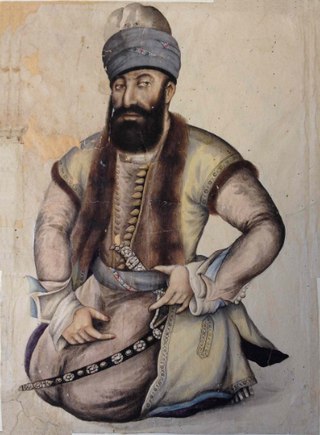
Mohammad Karim Khan Zand was the founder of the Zand Dynasty, ruling from 1751 to 1779. He ruled all of Iran (Persia) except for Khorasan. He also ruled over some of the Caucasian lands and occupied Basra for some years.

Mohammad-Ali Mirza Dowlatshah was a famous Iranian Prince of the Qajar dynasty. He is also the progenitor of the Dowlatshahi Family of Persia. He was born at Nava, in Mazandaran, a Caspian province in the north of Iran. He was the first son of Fath-Ali Shah, the second Qajar king of Persia, and Ziba Chehr Khanoum, a Georgian girl of the Tsikarashvili family. He was also the elder brother of Abbas Mirza. Dowlatshah was the governor of Fars at age 9, Qazvin and Gilan at age 11, Khuzestan and Lorestan at age 16, and Kermanshah at age 19.
The Zand tribe is a Laki-speaking Kurdish tribe mainly populating the countryside of Khanaqin in Iraq and in the provinces of Kurdistan and Hamadan of Iran.

Sadeq Khan Zand, also known as Mohammad Sadeq, was the fourth Shah of the Zand dynasty of Iran from August 22, 1779 until March 14, 1781.
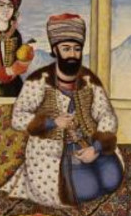
Ali-Morad Khan Zand was fifth ruler of the Zand dynasty of Iran, ruling from March 15, 1781, until February 11, 1785.

The Nakhichevan Khanate was a khanate under Iranian suzerainty, which controlled the city of Nakhichevan and its surroundings from 1747 to 1828.

The Persian campaign or invasion of Iran was a series of military conflicts between the Ottoman Empire, British Empire and Russian Empire in various areas of what was then neutral Qajar Iran, beginning in December 1914 and ending with the Armistice of Mudros on 30 October 1918, as part of the Middle Eastern Theatre of World War I. The fighting also involved local Persian units, who fought against the Entente and Ottoman forces in Iran. The conflict proved to be a devastating experience for Persia. Over 2 million Persian civilians died in the conflict, mostly due to the Armenian genocide by the Ottoman regime and Persian famine of 1917–1919, influenced by British and Russian actions. The Qajar government's inability to maintain the country's sovereignty during and immediately after the First World War led to a coup d'état in 1921 and Reza Shah's establishment of the Pahlavi dynasty.
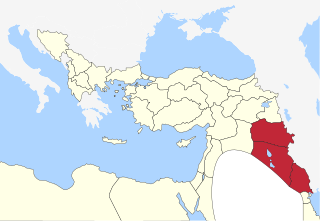
The Mamluk dynasty of Mesopotamia was a dynasty of Georgian Mamluk origin which ruled over Iraq in the 18th and early 19th centuries.
The Karai, Qarai, or Qara ("Black") Tartars are a Turkic tribe found in Khorasan, Azerbaijan, Kerman, and Fars.
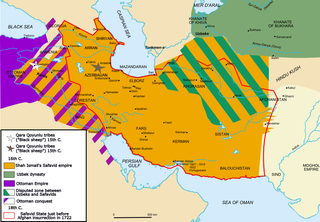
The Ottoman–Safavid War of 1623–1639 was a conflict fought between the Ottoman Empire and Safavid Iran, then the two major powers of Western Asia, over control of Mesopotamia. After initial Persian success in recapturing Baghdad and most of modern Iraq, having lost it for 90 years, the war became a stalemate as the Persians were unable to press further into the Ottoman Empire, and the Ottomans themselves were distracted by wars in Europe and weakened by internal turmoil. Eventually, the Ottomans were able to recover Baghdad, taking heavy losses in the final siege, and the signing of the Treaty of Zuhab ended the war in an Ottoman victory. Roughly speaking, the treaty restored the borders of 1555, with the Safavids keeping Daghestan, Shirvan, eastern Georgia, and Eastern Armenia, while western Georgia and Western Armenia decisively came under Ottoman rule. The eastern part of Samtskhe (Meskheti) was irrevocably lost to the Ottomans as well as Mesopotamia. Although parts of Mesopotamia were briefly retaken by the Iranians later on in history, notably during the reigns of Nader Shah (1736–1747) and Karim Khan Zand (1751–1779), it remained thenceforth in Ottoman hands until the aftermath of World War I.

The Kurdistan Democratic Party, usually abbreviated as KDP or PDK, is the largest party in Iraqi Kurdistan and the senior partner in the Kurdistan Regional Government. It was founded in 1946 in Mahabad in Iranian Kurdistan. The party states that it combines "democratic values and social justice to form a system whereby everyone in Kurdistan can live on an equal basis with great emphasis given to rights of individuals and freedom of expression."
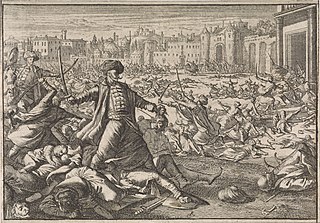
The recapture of Baghdad was the second conquest of the city by the Ottoman Empire as a part of the Ottoman–Safavid War of 1623–1639.

The Ottoman–Persian War of 1743–1746 was fought between the Ottoman Empire and Afsharid Iran.

Ala al-Dawla Bozkurt Beg was the ruler of the Dulkadir from late 1480 until his death. Championed by Ottoman Sultan Mehmed II, Bozkurt ousted his brother Shah Budak and claimed the throne. Early into his reign, Bozkurt assisted Mehmed's successor Bayezid II in pursuing his claimant brother Cem Sultan, who was harbored by the Mamluk Sultanate. In response, Bozkurt besieged Malatya, which prompted the Mamluks to initiate an offensive on him and the Ottomans. During the conflict, Bozkurt steered away from sending his support to the Ottomans, which contributed to their defeat by the Mamluks.

Mustafa Pasha Bajalan, was an Ottoman Kurdish general and administrator, He was the final head of the Bajalan family and his father was the last hereditary governor of the Pashlik of Zohab.
Ali Janbulad Pasha was a Kurdish tribal chief from Kilis and a rebel Ottoman governor of Aleppo who wielded practical supremacy over Syria in c. 1606–1607. His rebellion, launched to avenge the execution of his uncle Huseyn ibn Janbulad by the commander Jigalazade Sinan Pasha in 1605, gained currency among northern Syria's Kurdish, Turkmen and Arab tribes and expanded to include local Syrian governors and chiefs, most prominently Fakhr al-Din Ma'n of Mount Lebanon and his erstwhile enemy Yusuf Sayfa Pasha of Tripoli. Ali formed a secret military alliance with the Grand Duke of Tuscany, Ferdinand I, with the explicit aim of jointly destroying the Ottoman Empire and establishing the Janbulad family as the sovereigns of Syria.

The Baghdad Province was a province of the Safavid Empire, centred on the territory of the present-day Iraq. Baghdad was the provincial capital and the seat of the Safavid governors.

Afsharid Iran, also referred as the Afsharid Empire, was an Iranian empire established by the Turkoman Afshar tribe in Iran's north-eastern province of Khorasan, establishing the Afsharid dynasty that would rule over Iran during the mid-eighteenth century. The dynasty's founder, Nader Shah, was a successful military commander who deposed the last member of the Safavid dynasty in 1736, and proclaimed himself Shah.
References
- ↑ "Bajalan". IranicaOnline. Retrieved 24 March 2019.
- ↑ Moosa, Matti (1987). Extremist Shiites: The Ghulat Sects. USA: Syracuse University Press. p. 163. ISBN 0815624115.
- ↑ Soane, Ely Banister (1918). Notes on the Tribes of Southern Kurdistan. UK: Government Press. p. 3.
- ↑ Travels in Assyria, Media, and Persia, Volume 1, James Silk Buckingham
- ↑ Houtsma, M. Th (1993). First Encyclopaedia of Islam: 1913-1936. E.J. Brill. ISBN 9789004097964.
- ↑ Layard, Austen Henry (2011). Early Adventures in Persia, Susiana, and Babylonia: Including a Residence Among the Bakhtiyari and Other Wild Tribes Before the Discovery of Nineveh, Volume 1. UK: Cambridge University Press. p. 218. ISBN 9781108043427.
- ↑ Island of salvation, Włodzimierz Odojewski
- ↑ Ateş, Sabri (2013). Ottoman-Iranian Borderlands: Making a Boundary, 1843–1914. UK: Cambridge University Press. p. 106. ISBN 978-1107245082.
- ↑ Ateş, Sabri (2013). Ottoman-Iranian Borderlands: Making a Boundary, 1843–1914. UK: Cambridge University Press. p. 163. ISBN 978-1107245082.
- ↑ Historical gazetteer of Iran, Volume 3, Ludwig W. Adamec
- ↑ The Kurds, Issue 4, David McDowall
- ↑ History of the wars: (1721-1736), Abraham Erewantsʻi, George A. Bournoutian
- ↑ Minorsky, Vladimir (1931). Medieval Iran and its neighbours, Volume 1. Russia: Variorum Reprints. p. 253. ISBN 0860781143.
- ↑ Persia and the Persian question, Volume 2, George Nathaniel Curzon of Kedleston (Marquess)
- ↑ Nadir Shah: a critical study based mainly upon contemporary sources, Laurence Lockhart
- ↑ Yar-Shater, Ehsan (1988). Encyclopaedia iranica, Volume 3, Issues 5-8. USA: Routledge & Kegan Paul. p. 533.
- ↑ Curzon, Robert (1854). Armenia: A Year at Erzeroom, and on the Frontiers of Russia, Turkey, and Persia. John Murray. p. 81.
- ↑ Mustafa Barzani and the Kurdish liberation movement 1931-1961, Masʻūd Bārzānī, Ahmed Ferhadi.
- ↑ Journal of the Royal Asiatic Society of Great Britain and Ireland. Cambridge University Press. 1921. p. 58.